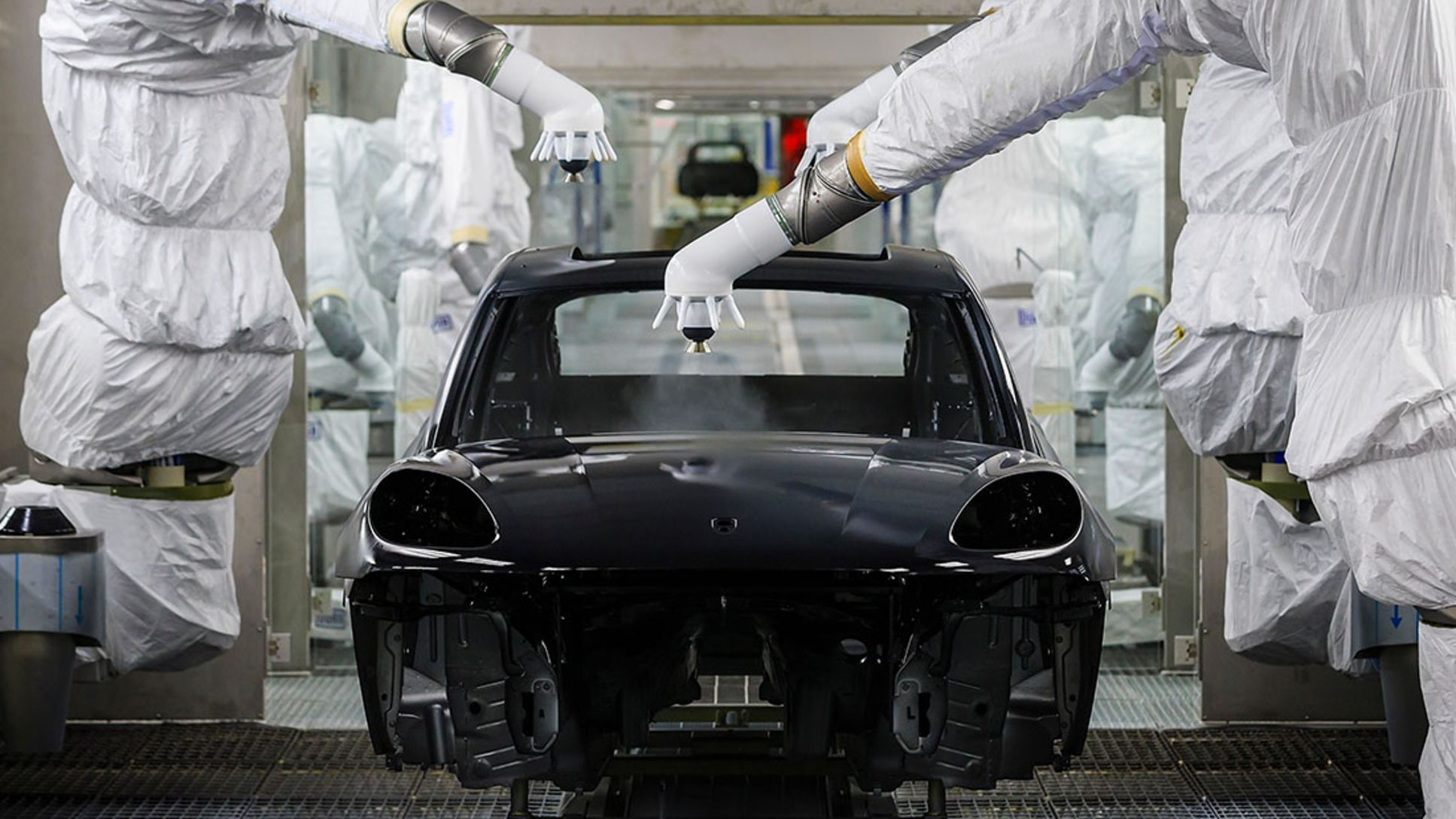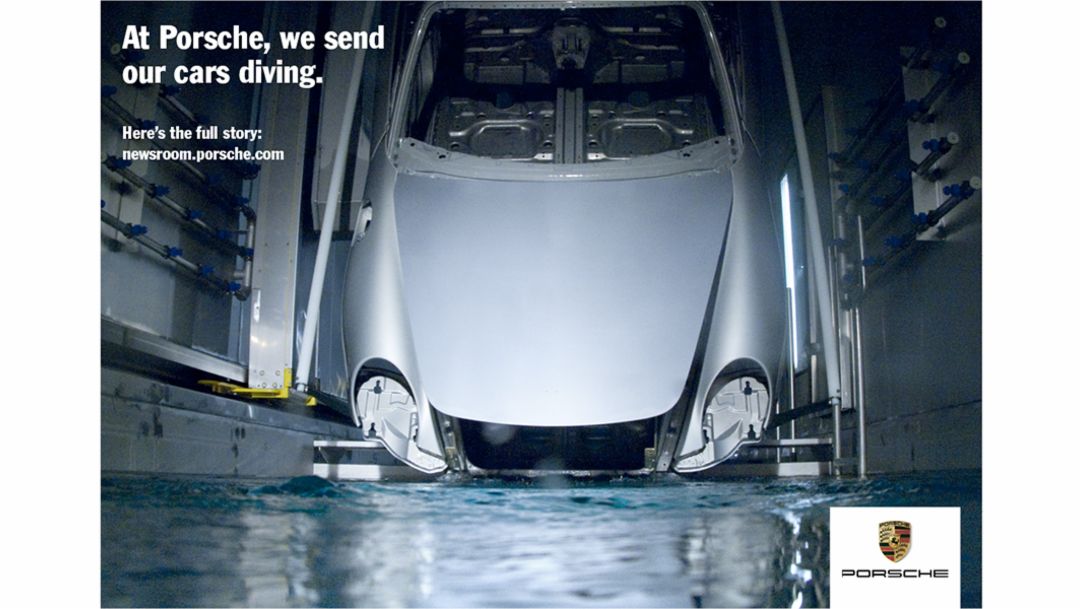Stage 1 – pretreatment for cathodic dip coating
In pretreatment, the body is cleaned and degreased in a dipping tank heated to 60° C. This removes materials such as grease from the presses, metal chips and other contaminants from the body manufacturing process. Now the body is free of grease for the first layer of paint. This is followed by a phosphating process, in which a zinc phosphate coating is applied in a dip tank. It ensures optimal adhesion for the corrosion protection coating that follows later. The body of the Macan is not only dipped into the tank here, but is also rotated 360 degrees, so that all cavities are reached.
Stage 2 – Cathodic Dip Coating (CDC)
In cathodic dip coating, the body is coated with high-quality corrosion protection by dipping it into a primer heated to 33° C. To ensure that all surfaces – even in cavities – are optimally wetted, the body is rotated about its axis in the dip tank. The dipping process is referred to as cathodic, because the solids in the paint are deposited on the body surface by electrophoresis – as a result of a voltage differential of 380 volts that is applied between the dip tank and the body. The resulting voltage distribution in the body yields a very uniform coating. The body is dipped in a total of nine tanks during pretreatment and cathodic dip coating.
Stage 3 – CDC drying unit
Afterwards, the cathodic dip coating of the body is allowed to drip, and then it is dried in a number of drying stages. Here, the Macan body is conveyed into the first of a total of four dryers during the painting process. The first dryer, the cathodic dip coating dryer, reaches a peak temperature of 185° C. After this stage, up to 80 bodies are parked in a colour sorting buffer area, where vehicles with the same colours are bundled.
Stage 4 – sealing of seams
Special PVC materials are used to seal the seams and flanges, so that no water can ingress later on. The sealing process is performed fully automatically by robots. Underbody protection is also applied. It consists of a PVC-containing material and protects the body against stone impact. In addition, the seams at the doors, bonnet and boot lid are sealed. Very stringent quality standards apply to the visible seams. In this area, the body is removed from the skid and placed on a hanger; at the end of the process, it is returned to a skid for the primer surfacer coat and top coat.
Stage 5 – filler, top coat, clear coat
Now, the actual paint layers are applied at a precisely defined air humidity and temperature. All paint layers – filler, base paint and clear coat – are applied by painting robots with electrostatic paint charging, on both interior and exterior body surfaces. The filler is 30 to 35 µm thick, and the base coat is 12 to 18 µm thick (depending on the specific colour), while the clear coat is another 40 to 45 µm. In painting, a maximum of 85 per cent of the sprayed paint reaches the body surface. The excess paint is filtered from the air to reduce emissions. A fresh air stream at a precisely regulated temperature and humidity carries the paint particles into the paint separator beneath the spray booth. In conventional systems, the solid paint particles are bound by water and chemicals and are discharged. In the new dry separator system developed by Dürr and used in Leipzig, on the other hand, the excess paint particles are bound by powdered limestone already in the air stream from which they are filtered out and disposed. The benefit is that this does not require 100 per cent pure fresh air, and the booths can be operated with recirculation air. That reduces energy requirements significantly.
It begins with the primer surfacer coat that provides stone impact protection and is available in three colours (White, Anthracite and Light Blue). It is already colour coordinated with the top coat that follows. The elastic surfacer is also referred to as the primer; as a substrate it protects the top coat from damage and simultaneously improves its structure. Before the top coat is applied, the body is run through a dryer unit heated to 160° C.
Now the top coat or base paint follows – and with it the colour of the Macan that is configured by the buyer. To ensure that everything operates ideally, there are not only painting robots in the painting booths, but also handling robots that open the doors or the bonnet and boot lid. The paints themselves flow through the ring lines to the painting robot. Then the top coat undergoes intermediate drying at 80° C.
Finally, the paint coat is sealed by a clear coat – this is referred to as a top coat finish. Fully painted, the Macan body now passes through the third main drying unit; here, the paint is cured at a temperature of 140° C. for around 45 minutes.
Stage 6 – light tunnel
In the final phase, the paint jobs on the bodies are monitored on the finishing line, and any painting defects are eliminated. In addition, the vehicles are sent through a newly developed light tunnel. This tunnel is equipped with very energy-efficient LED modules. Their light is projected onto the bodies via adjustable mirrors. This generates a very uniform light strip that lets employees detect even very minor bump imperfections on the paint surface. In contrast to tunnel systems with fluorescent tubes, the new ergo-lux tunnel of the Porsche plant in Leipzig not only detects defects better but thanks to the LEDs it utilises, it also saves on energy. This better economy is associated with less energy being converted to heat. In turn, this noticeably improves the climatic working conditions of employees in the light tunnel. The untreated body has become a high-gloss and cavity-sealed Macan, which can now be transported to the assembly area.
Consumption data
Macan: Combined fuel consumption: 9.2 – 6.1 l/100 km; CO₂ emission: 216 – 159 g/km

